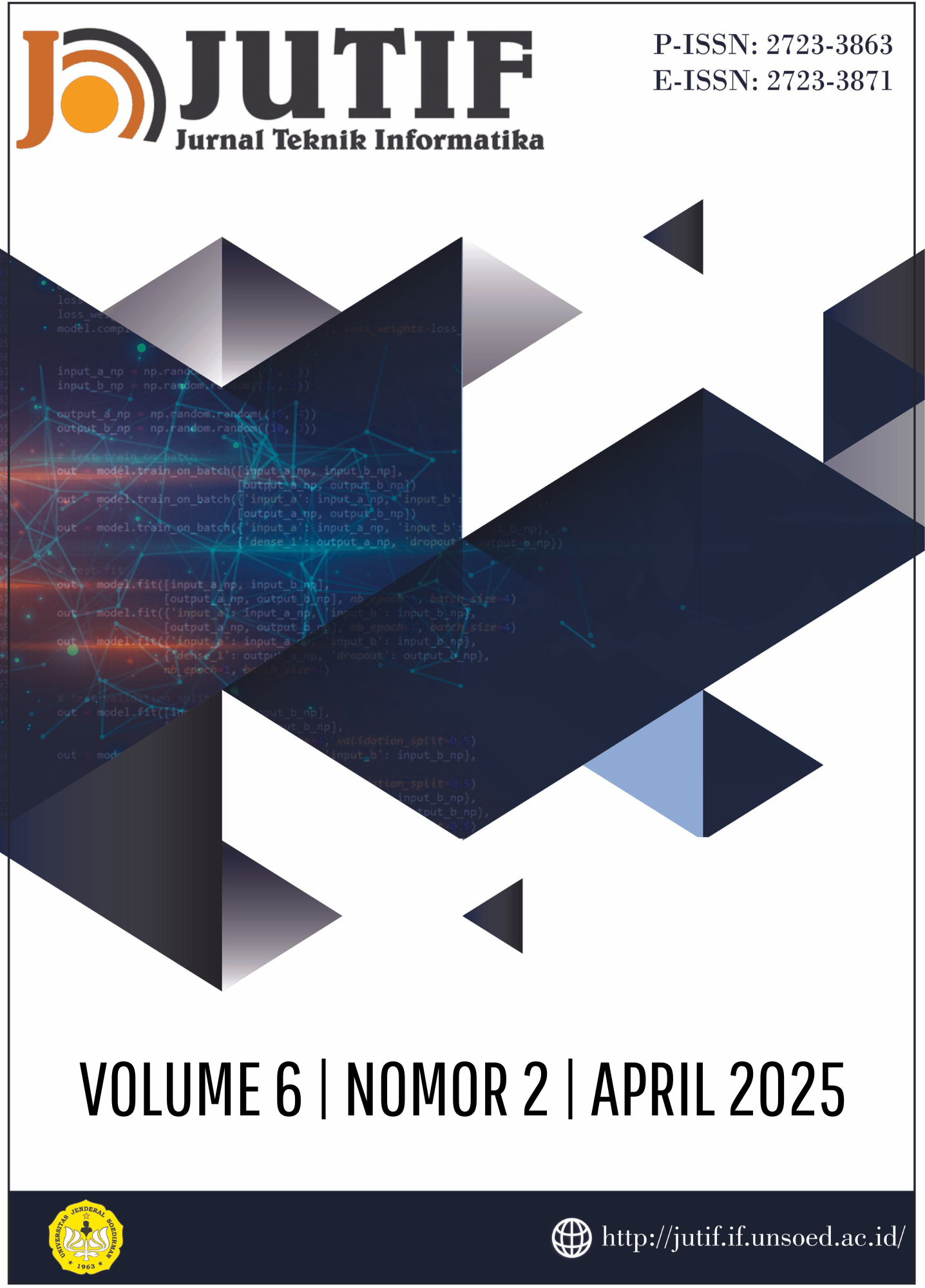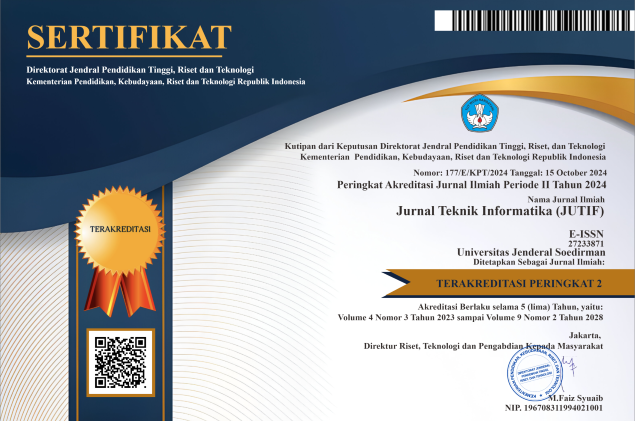Enhancing MPEG-1 Video Quality Using Discrete Wavelet Transform (DWT) with Coefficient Factor and Gamma Adjustment
DOI:
https://doi.org/10.52436/1.jutif.2025.6.2.4422Keywords:
Coefficient Factor, Discrete Wavelet Transform, Gamma Adjustment, Video Enhancement, Visual QualityAbstract
Low-quality video caused by compression artifacts, noise, and loss of detail remains a significant challenge in video processing, affecting applications in streaming, surveillance, and medical imaging. Existing enhancement techniques often struggle with excessive noise amplification or high computational complexity, making them inefficient for real-time applications. This study proposes an improved video enhancement method using Discrete Wavelet Transform (DWT) with optimized coefficient factor and gamma adjustment. DWT is a mathematical approach that decomposes video frames into frequency subbands, enabling selective enhancement of important details. To analyze the impact of different wavelets, this study evaluates Coif5, db1, sym4, and sym8 wavelets. The sym8 wavelet, known for its high symmetry and ability to minimize artifacts, achieves the best results in preserving fine details and structural integrity. The coefficient factor is dynamically adjusted to sharpen details while preventing noise amplification, and gamma adjustment is applied to optimize brightness and contrast. The proposed method was evaluated using Mean Squared Error (MSE), Peak Signal-to-Noise Ratio (PSNR), and Structural Similarity Index (SSIM). Experimental results show that sym8 wavelet with gamma 0.7 and coefficient factor 0.3 provides the best balance, achieving an MSE of 0.062, a PSNR of 12.050 dB, and an SSIM of 0.674, outperforming Coif5, db1, and sym4 wavelets. The results indicate that wavelet selection significantly impacts video enhancement performance, with sym8 providing superior contrast enhancement and noise suppression. This study contributes to real-time video processing and AI-based applications, ensuring enhanced visual quality with minimal computational overhead.
Downloads
References
W. D. Ferreira, C. B. R. Ferreira, G. da Cruz Júnior, and F. Soares, “A review of digital image forensics,” Computers & Electrical Engineering, vol. 85, p. 106685, Jul. 2020, doi: 10.1016/j.compeleceng.2020.106685.
E. Venter, “Challenges for meaningful interpersonal communication in a digital era,” HTS Teologiese Studies / Theological Studies, vol. 75, no. 1, 2019, doi: 10.4102/hts.v75i1.5339.
R. A. El-Shahed, M. N. Al-Berry, H. M. Ebeid, and H. A. Shedeed, “Multi-resolution Video Steganography Technique Based on Stationary Wavelet Transform (SWT) and Singular Value Decomposition (SVD),” in International Conference on Innovative Computing and Communications, A. Khanna, D. Gupta, S. Bhattacharyya, A. E. Hassanien, S. Anand, and A. Jaiswal, Eds., Singapore: Springer Singapore, 2022, pp. 157–169. doi: 10.1007/978-981-16-3071-2_15.
C. A. Sari, M. H. Dzaki, E. H. Rachmawanto, R. R. Ali, and M. Doheir, “High PSNR Using Fibonacci Sequences in Classical Cryptography and Steganography Using LSB,” International Journal of Intelligent Engineering and Systems, vol. 16, no. 4, pp. 568–580, 2023, doi: 10.22266/ijies2023.0831.46.
D. Wu, R. Li, B. Rekabdar, C. Talbert, M. Edidem, and G. Wang, “Classification of drainage crossings on high-resolution digital elevation models: A deep learning approach,” GIsci Remote Sens, vol. 60, no. 1, 2023, doi: 10.1080/15481603.2023.2230706.
L. Liu et al., “Low-light video enhancement with synthetic event guidance,” in Proceedings of the AAAI Conference on Artificial Intelligence, 2023, pp. 1692–1700.
W. S. Sari, E. H. Rachmawanto, D. R. I. M. Setiadi, and C. A. Sari, “A Good Performance OTP encryption image based on DCT-DWT steganography,” Telkomnika (Telecommunication Computing Electronics and Control), vol. 15, no. 4, pp. 1987–1995, Dec. 2017, doi: 10.12928/TELKOMNIKA.v15i4.5883.
A. Alzahrani, “Enhanced invisibility and robustness of digital image watermarking based on DWT-SVD,” Appl Bionics Biomech, vol. 2022, 2022.
K. S. Mann and S. S. Mann, “Py-MLBUF: Development of an online-platform for gamma-ray shielding calculations and investigations,” Ann Nucl Energy, vol. 150, p. 107845, Jan. 2021, doi: 10.1016/j.anucene.2020.107845.
A. T. Priandika et al., “Video Editing Training to Improve the Quality of Teaching and Learning at SMK Palapa Bandarlampung,” Journal of Engineering and Information Technology for Community Service, vol. 1, no. 2, pp. 26–30, Nov. 2022, doi: 10.33365/jeit-cs.v1i2.134.
F. Ernawan, “An improved hiding information by modifying selected DWT coefficients in video steganography,” Multimed Tools Appl, vol. 83, no. 12, pp. 34629–34645, Sep. 2023, doi: 10.1007/s11042-023-17113-y.
J. Khandelwal, V. K. Sharma, D. Singh, and A. Zaguia, “Dwt-svd based image steganography using threshold value encryption method,” Computers, Materials and Continua, vol. 72, no. 2, pp. 3299–3312, 2022, doi: 10.32604/cmc.2022.023116.
A. A. Arrasyid, D. R. I. M. Setiadi, M. A. Soeleman, C. A. Sari, and E. H. Rachmawanto, “Image Watermarking using Triple Transform (DCT- DWT-SVD) to Improve Copyright Protection Performance,” in 2018 International Seminar on Research of Information Technology and Intelligent Systems (ISRITI), IEEE, Nov. 2018, pp. 522–526. doi: 10.1109/ISRITI.2018.8864461.
D. Sengupta, A. Biswas, and P. Gupta, “Non-linear weight adjustment in adaptive gamma correction for image contrast enhancement,” Multimed Tools Appl, vol. 80, no. 3, pp. 3835–3862, Jan. 2021, doi: 10.1007/s11042-020-09583-1.
E. E. D. Hemdan, “An efficient and robust watermarking approach based on single value decompression, multi-level DWT, and wavelet fusion with scrambled medical images,” Multimed Tools Appl, vol. 80, no. 2, pp. 1749–1777, Jan. 2021, doi: 10.1007/s11042-020-09769-7.
J.-J. Jeon, T.-H. Park, and I.-K. Eom, “Sand-Dust Image Enhancement Using Chromatic Variance Consistency and Gamma Correction-Based Dehazing,” Sensors, vol. 22, no. 23, p. 9048, Nov. 2022, doi: 10.3390/s22239048.
A. Kumar, R. K. Jha, and N. K. Nishchal, “An improved Gamma correction model for image dehazing in a multi-exposure fusion framework,” J Vis Commun Image Represent, vol. 78, p. 103122, Jul. 2021, doi: 10.1016/j.jvcir.2021.103122.
G. Ardiansyah, C. A. Sari, D. R. I. M. Setiadi, and E. H. Rachmawanto, “Hybrid method using 3-DES, DWT and LSB for secure image steganography algorithm,” in 2017 2nd International conferences on Information Technology, Information Systems and Electrical Engineering (ICITISEE), 2017, pp. 249–254. doi: 10.1109/ICITISEE.2017.8285505.
A. O. Mohammed, H. I. Hussein, R. J. Mstafa, and A. M. Abdulazeez, “A blind and robust color image watermarking scheme based on DCT and DWT domains,” Multimed Tools Appl, vol. 82, no. 21, pp. 32855–32881, Sep. 2023, doi: 10.1007/s11042-023-14797-0.
C. Dong, H. Ma, Z. Li, L. Li, and D. Liu, “Temporal Wavelet Transform-Based Low-Complexity Perceptual Quality Enhancement of Compressed Video,” IEEE Transactions on Circuits and Systems for Video Technology, vol. 34, no. 5, pp. 4040–4053, May 2024, doi: 10.1109/TCSVT.2023.3316834.
J. Zhang, S. Jia, Z. Yu, and T. Huang, “Learning Temporal-Ordered Representation for Spike Streams Based on Discrete Wavelet Transforms,” Proceedings of the AAAI Conference on Artificial Intelligence, vol. 37, no. 1, pp. 137–147, Jun. 2023, doi: 10.1609/aaai.v37i1.25085.
K. Venkata Ramana, C. Sowntharya, K. Jithesh, P. Lokeshwara Reddy, M. C. Apoorva, and A. Kumar, “DWT Algorithm for Macro & Micro Block based Multiple Histogram Shifting for Video Data Hiding,” in 2022 International Conference on Automation, Computing and Renewable Systems (ICACRS), IEEE, Dec. 2022, pp. 1121–1127. doi: 10.1109/ICACRS55517.2022.10029082.
S. S. Rao, G. K. Narula, R. Sudhir, S. S, R. B, and B. B, “Video Codec IP using Discrete Wavelet Transform,” in 2021 International Conference on Smart Generation Computing, Communication and Networking (SMART GENCON), IEEE, Oct. 2021, pp. 1–7. doi: 10.1109/SMARTGENCON51891.2021.9645895.
M. J. Altalqani and Z. J. Jaber, “Improving The Security Of Steganography In Video Using Genetic Algorithm,” 2021.
S. Sarkar and S. S. Bhairannawar, “Efficient FPGA architecture of optimized Haar wavelet transform for image and video processing applications,” Multidimens Syst Signal Process, vol. 32, no. 2, pp. 821–844, Apr. 2021, doi: 10.1007/s11045-020-00759-4.
F. Z. BOUKHOBZA, A. HACINE GHARBI, and K. ROUABAH, “A New Facial Expression Recognition Algorithm Based on DWT Feature Extraction and Selection,” The International Arab Journal of Information Technology, vol. 21, no. 4, 2024, doi: 10.34028/iajit/21/4/6.
J. Begal, E. Sabo, N. Goldberg, A. Bitterman, and W. Khoury, “Wavelets-Based Texture Analysis of Post Neoadjuvant Chemoradiotherapy Magnetic Resonance Imaging as a Tool for Recognition of Pathological Complete Response in Rectal Cancer, a Retrospective Study,” J Clin Med, vol. 13, no. 23, p. 7383, Dec. 2024, doi: 10.3390/jcm13237383.
H. Schwarz et al., “Quantization and Entropy Coding in the Versatile Video Coding (VVC) Standard,” IEEE Transactions on Circuits and Systems for Video Technology, vol. 31, no. 10, pp. 3891–3906, Oct. 2021, doi: 10.1109/TCSVT.2021.3072202.
Y. Lee, S. Zhang, M. Li, and X. He, “Blind inverse gamma correction with maximized differential entropy,” Signal Processing, vol. 193, p. 108427, Apr. 2022, doi: 10.1016/j.sigpro.2021.108427.
U. Sara, M. Akter, and M. S. Uddin, “Image Quality Assessment through FSIM, SSIM, MSE and PSNR—A Comparative Study,” Journal of Computer and Communications, vol. 07, no. 03, pp. 8–18, 2019, doi: 10.4236/jcc.2019.73002.
E. A. Sofyan, C. A. Sari, H. Rachmawanto, and R. D. Cahyo, “High-Quality Evaluation for Invisible Watermarking Based on Discrete Cosine Transform (DCT) and Singular Value Decomposition (SVD),” Advance Sustainable Science, Engineering and Technology (ASSET), vol. 6, no. 1, 2024, doi: 10.26877/asset.v6i1.17186.
E. R. Pramudya et al., “Optimation of image encryption using fractal Tromino and polynomial Chebyshev based on chaotic matrix,” TELKOMNIKA (Telecommunication Computing Electronics and Control), vol. 22, no. 6, p. 1529, Aug. 2024, doi: 10.12928/telkomnika.v22i6.26080.
C. A. Sari et al., “A Chaotic Image Encryption Based on Random Noise and Arnold Cat Maps,” in 2024 International Seminar on Application for Technology of Information and Communication (iSemantic), 2024, pp. 347–352. doi: 10.1109/iSemantic63362.2024.10762216.
Additional Files
Published
How to Cite
Issue
Section
License
Copyright (c) 2025 Andi Danang Krismawan, Ajib Susanto, Eko Hari Rachmawanto, Muslih, Christy Atika Sari, Rabei Raad Ali

This work is licensed under a Creative Commons Attribution 4.0 International License.



























